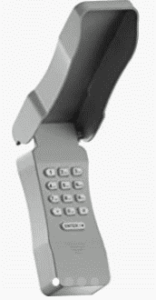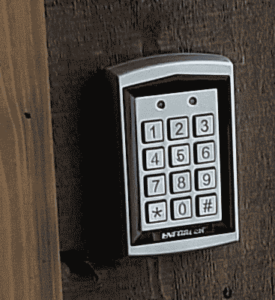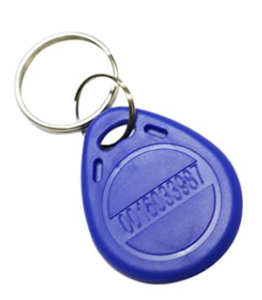
Why is it that nearly every homeowner chooses to install the dopey garage door keypad shown at right? I suppose the answer is that most of the time, the homeowner is not the person who actually makes the choice. The choice is usually made by the company that installs the garage door opener. The company that installs the garage door opener does not know any better — this is the only kind of keypad that they know how to install. It is the only kind of keypad that is made by the company that makes the garage door opener. But this keypad is dopey. It only has one code number. If you give out the code number to somebody, say a plumber, and later the plumber does not really need access any more, what are you going to do? Change the code number? Sure, except that now you have to somehow communicate the new code number to all of the other people who still need to have access. They now all have to memorize the new code number. There must be a better way. And of course there is a better way.

The better way is to use a smarter keypad. There are many smarter keypads. My favorite is the keypad shown at right, the fetchingly named Seco-Larm SK-1323-SPQ keypad (Amazon). This keypad can store something like 99 code numbers. Each of your people who might need to get in can have their own personal code number. If you later decide that the plumber no longer ought to have access, then you simply delete the plumber’s code number from the memory of the keypad. But nothing about this requires the other people to learn a new code number.

Not only that, this keypad also reads little blue key fobs (Amazon). So you can set it up so that some of your people have little blue key fobs. Each key fob has its own unique ID number inside. You can keep track of which person has which key fob. If you later decide that somebody’s key fob should not work any more, you simply delete that key fob ID number from the memory of the keypad.
At night, the keypad glows with a subtle blue glow, so if you are standing in front of the keypad at night, it is easy to see the numbers of the keys so that you can key in your code number.
The dopey keypad is, of course, very easy to install. It communicates wirelessly to the garage door opener, just like the remote transmitter that you might clip to the sun visor in your car. So there is no need to run any wiring from this dopey keypad to anywhere else. The ease of installation makes it a very attractive choice for the installer. This also means it has to be battery powered, and this means that eventually the battery will run down, probably at some inconvenient moment.
In contrast, yes I will acknowledge the smart keypad that I like better actually does require that wiring be run from one place to another place. An AC adapter needs to be plugged in somewhere to provide power to this keypad. The keypad provides “dry relay contacts” for triggering the opening and closing of the garage door, and this assumes that the garage door opener can be triggered in this way. Unfortunately what I have found is that some of the modern-day garage door openers are designed in a nasty way so that the controller for opening and closing the garage door is not an ordinary SPST pushbutton but is instead a complicated electronic device. The controller connects to the opener with two wires, but if you short the two wires together, this does not make the garage door open or close. What I find with such modern-day garage door openers is that I have to open up the controller and solder some wires into place to parallel the SPST button contacts that are inside the controller.

I have been using the keypads of the type shown and they have all had the ability to add a second temporary code and set up the number of times it can be used.
This is good to know. I bet that most homeowners are not aware of this feature. Thank you for posting this comment.
I guess to make use of this feature you have to (a) be there in person at the keypad and (b) remember how to set up the temporary code number.
If you are away from the house on a particular day and that is the day that you suddenly learn you need to let a plumber into the house, then the ability to program in a temporary code if you had happened to be there in person might not be as much help as one might think. I guess the smart thing would be to program in the temporary code in advance of need, write it down somewhere so that you can find it again in a hurry, and then keep it handy so that on the frantic day that you are away from the house and you suddenly learn that you need to let the plumber into the house, you can provide the temporary code number to the plumber.
The same sort of thing can be done with the fancy keypad in this blog article. The user can program in a handful of codes in advance of need, and write them down and then hand them out as needed to emergency plumbers or whatever. Later the user can delete a code from the keypad when it is no longer needed to be active.
Know what else is dopey? The standard ones are 4-digit codes. Every night, the cover on ours in the alley is closed, and every morning it’s open. I think someone is cycling through all 10,000 codes to see if they can get free bikes.
Little do they know that the buttons on ours are very flaky and barely work when you know the code. Which is why I wired up an internet-connected door trigger a while back. Very un-dopey, and now I get additional goodies like a phone alert when the door has been open extra long.
Yeah I have wondered about this. The fancy keypad that I cite above can be set to use your choice of 4-digit or 5-digit or 6-digit codes.
What would be nice is if a simple garage-style keypad could be configured to simply stop listening to code attempts for, say, half an hour after half a dozen failed attempts.
The security system that I use for all of my locations (house, office, other places) is the old rock-steady DSC system and it can be configured to have a timeout like that.
Your comment inspired me to write a blog article about internet-connected garage door triggers. Thank you.